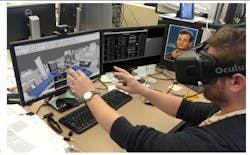Gestural Modeling
It sounds like something out of science fiction, but in a reality version of movie, Inception—in which Leonardo DiCaprio’s character constructs imaginary immersive worlds in which others interact—architect Casey Mahon brings DiCaprio’s role to life by donning a pair of virtual reality goggles integral to software and sensors. His hands trigger computational processes in architectural software—what he refers to as gestural modeling. The ability to manipulate immersive environments is impacting the way firms practice, says Mahon, digital technologies manager at Carrier Johnson CULTURE and contributing faculty member at NewSchool of Architecture & Design’s School of Architecture.
Carrier Johnson CULTURE has integrated virtual reality into immersive client presentations; it’s more communicative than looking at renderings, or even a scale model, says Mahon. “The virtual experience of space and walking around in it facilitates better feedback and conversations with the client.”
For those concerned about motion sickness, Mahon says biofeedback can prevent the issue. “Without the tactile feedback we’re asking our brain to do a whole lot extra; I believe that when a final product comes out, there are integrated air puffs, clicks or vibrations and headphones—so it’s a total immersive A/V experience.”
Gestural modeling takes virtual reality to the next level in architecture by letting the designer step into the space at true scale and move and push walls to widen a hallway for instance; but commanding a mouse and keyboard while blinded [by goggles] can be frustrating, so Mahon developed a series of hand gestures that correspond to commands in the design program. Perceived and translated by sensors, the gestures affect the 3D model. This takes considerable stamina, remarks Mahon. “You’d be shocked at how exhausting it is to have your hand floating over your desk for long periods of time.” On the other hand, it’s a time-saver,” says Mahon. “If this were a physical model and we were going to chamfer off the side of that cube, there would be a whole [long] discussion about it.”
In practice, this is sort of a dangerous tool, cautions Mahon, who continues a philosophical examination of the implications of his work. “We need to understand what it means to be in this 3D representation, before we actually start working with it.” He references a French philosopher who sees digital maps as a form of augmented reality created and inhabited by humans. “I see virtual reality as saying we don’t need to fight scale, and we don’t have this challenge anymore, we can design and experience our spaces in the size that they actually will be.”
